Imagine this: a venomous, fast-flying, stinging insect who is attracted to you by your sweat. Sounds like something pulled from the pages of your favorite horror novel, right? However, sweat bees are far from fiction. Sweat bees are a very real and very common bee that is known to be a nuisance during the hot summer months. So what exactly are they? And are they as terrifying as they sound?
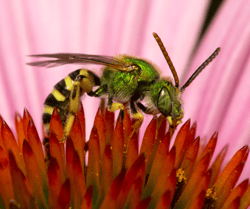 Sweat bee on a flower
Sweat bee on a flower
Sweat Bees: Appearance and Biology
Sweat bees are a diverse group of bees belonging to the family Halictidae, which includes more than 1,000 species worldwide. They are called sweat bees because they are attracted to the salt in human sweat, which they use as a source of nutrients. Sweat contains both salt and various nutrients that sweat bees need, such as amino acids and proteins.
Sweat bees are generally small to medium-sized, ranging from 3 to 15 millimeters in length, and are often brightly colored with green, blue, or metallic hues. They have slender bodies and wings that are folded flat over their abdomen when at rest. Many sweat bees have a similar general appearance to other types of bees, such as honeybees and bumblebees.
In terms of their biology, sweat bees are solitary or social insects that live in a wide variety of habitats, including meadows, forests, and deserts. The distribution of sweat bees varies by species, but many are found throughout North America, Central and South America, Europe, Africa, Asia, and Australia. Some species have even been found in the Arctic and Antarctic regions. Regardless of region, sweat bees are important pollinators, with some species specializing in pollinating certain types of flowers.
Most sweat bees are ground-nesting, meaning they build their nests in the soil. Females create tunnels in the ground, where they lay their eggs and provide food for their larvae. Some species are also known to nest in wood or in crevices in rocks.
 Sweat contains both salt and various nutrients that sweat bees need, such as amino acids and proteins.
Sweat contains both salt and various nutrients that sweat bees need, such as amino acids and proteins.
Are Sweat Bees Dangerous?
Sweat bees are generally not considered to be dangerous to humans or pets, as they are non-aggressive and rarely sting unless provoked or threatened. However, like all bees, sweat bees are capable of stinging if they feel threatened or if their nest is disturbed. When a sweat bee stings, its stinger becomes embedded in the skin of its victim, and the bee cannot remove it. The bee dies shortly after delivering the sting. It’s important to note that male sweat bees are incapable of stinging due to lacking a stinger; in females, the stinger doubles as an ovipositor for egg-laying purposes.
The sting of a sweat bee is usually mild and not harmful to most people, but some individuals may experience an allergic reaction. If you experience severe symptoms after being stung by a sweat bee, seek medical attention immediately. In addition, pets (like humans) may also be stung by sweat bees, but they are generally not at risk of serious harm unless they have an allergic reaction. However, if you notice your pet has been stung by a sweat bee and is experiencing symptoms such as swelling or difficulty breathing, contact your veterinarian immediately.
Overall, while sweat bees may sting if provoked or threatened, they are not considered dangerous to humans or pets, and they play an important role in pollination in many ecosystems.
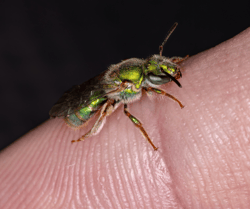 Sweat bee on human finger
Sweat bee on human finger
How do Sweat Bees Benefit the Ecosystem?
We know that sweat bees are important pollinators in many ecosystems – but why? Sweat bees are helpful as they are attracted to a wide range of flowers and plants, and their small size and hairy bodies make them effective pollinators for many types of crops and wildflowers. Some sweat bees even specialize in pollinating specific plant species such as fruit trees and vegetable crops like tomatoes, squash, and cucumbers.
Sweat bees collect pollen and nectar from flowers using their specialized mouthparts and hairy bodies, and as they move from flower to flower, they transfer pollen from the male reproductive structures (anthers) to the female reproductive structures (stigmas) of the flowers. This process, known as pollination, is essential for the reproduction of many plant species.
In addition to pollinating crops and wildflowers, sweat bees also play an important role in the reproduction of many native plant species. Many native plants rely on sweat bees and other native pollinators for their reproduction, and without these pollinators, these plants would not be able to reproduce and would decline in population.
Overall, sweat bees are important pollinators that play a crucial role in maintaining the health and diversity of many ecosystems. By pollinating a wide range of plants and flowers, sweat bees help to ensure the reproduction and survival of many plant species, which in turn provides food and habitat for other animals in the ecosystem.
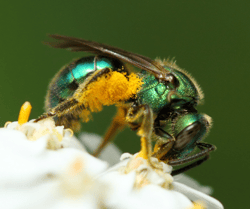 Their small size and hairy bodies make them effective pollinators for many types of crops and wildflowers.
Their small size and hairy bodies make them effective pollinators for many types of crops and wildflowers.
Can I Prevent Sweat Bees In And Around My Home?
At EcoShield, we believe that prevention is always the best first line of defense in pest control. That said, preventing bees that are attracted to human sweat can be a tricky endeavor. However, there are a few tips that may discourage sweat bees from nesting or foraging in your yard or garden, such as:
- Remove standing water: Sweat bees are attracted to areas with standing water, so it's important to eliminate any sources of standing water in your yard, such as buckets, bird baths, or other containers that collect water.
- Keep your lawn mowed: Sweat bees may be attracted to tall grasses and weeds, so it may help to keep your lawn mowed and weeds under control.
- Seal gaps and cracks: Sweat bees may nest in gaps or cracks in walls or other structures, so it's recommended to seal any gaps or cracks with caulk or other sealants. A trusted pest professional can help identify potential nesting sites that should be rectified to avoid sweat bees (and other bee species) building nests nearby.
- Avoid wearing scented products: Sweat bees are attracted to floral scents, so avoid wearing perfumes or scented lotions when you are spending time outdoors.
- Use insect repellent: If you are spending time outdoors and are concerned about sweat bees, you can use an insect repellent containing DEET or other effective ingredients to discourage them from landing on you.
It's important to note that sweat bees are important pollinators and play a crucial role in many ecosystems. If you do encounter sweat bees in your yard or garden, try to avoid disturbing them and allow them to continue their important work as pollinators. If you are allergic to sweat bees or otherwise concerned about them nesting in or around your home, it's best to contact a professional pest control company for assistance.
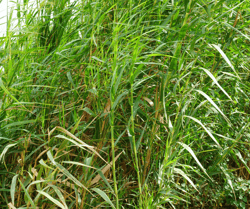 Sweat bees may be attracted to tall grasses, so it may help to keep your lawn mowed.
Sweat bees may be attracted to tall grasses, so it may help to keep your lawn mowed.
What should I do if I have a problem with sweat bees?
Sweat bees are generally not aggressive and do not usually cause significant problems for humans. If the sweat bees are not harming you or your family, we encourage you to consider allowing them to stay and carry out their important work in pollinating local plant life. However, if you have a large number of sweat bees in your yard or garden and are concerned about the risk of stings, it is best to call a reputable pest control company like EcoShield to assist in removing and/or relocating the nest.
If you are concerned about sweat bees in or around your home and yard, give EcoShield a call or fill out the form on this page today for a free no obligation quote.
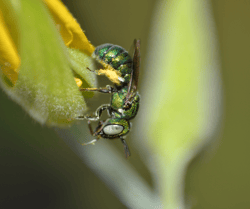 Sweat bee on plant
Sweat bee on plant